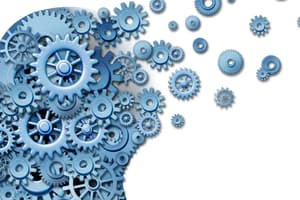Podcast
Questions and Answers
What is the primary argument made by Jerry Fodor in his book The Modularity of Mind?
What is the primary argument made by Jerry Fodor in his book The Modularity of Mind?
- The mind is organized into faculties such as memory and attention.
- The mind is organized into specialized information-processing modules. (correct)
- The mind is incapable of processing information.
- The mind is a single, unified processing system.
What is a characteristic of modular processing, according to Fodor's theory?
What is a characteristic of modular processing, according to Fodor's theory?
- It operates quickly and efficiently. (correct)
- It is a voluntary process that can be switched off.
- It is affected by background knowledge and expectations.
- It is a high-level, open-ended process.
What is the term used to describe Fodor's proposed modules, which are informationally encapsulated?
What is the term used to describe Fodor's proposed modules, which are informationally encapsulated?
- Modular faculties
- Informational capsules
- Fodorean modules (correct)
- Fodorean faculties
What is an example of a specialized information-processing task, according to Fodor's theory?
What is an example of a specialized information-processing task, according to Fodor's theory?
What is a consequence of the mandatory application of modular processing, according to Fodor's theory?
What is a consequence of the mandatory application of modular processing, according to Fodor's theory?
What is the primary distinction between modular and nonmodular processing, according to Fodor's theory?
What is the primary distinction between modular and nonmodular processing, according to Fodor's theory?
What is the primary reason why people are better at reasoning with deontic conditionals than with nondeontic conditionals?
What is the primary reason why people are better at reasoning with deontic conditionals than with nondeontic conditionals?
What is the function of the buffers in the ACT-R architecture?
What is the function of the buffers in the ACT-R architecture?
What is the role of the pattern-matching module in ACT-R?
What is the role of the pattern-matching module in ACT-R?
What is the characteristic of the modules in the ACT-R architecture?
What is the characteristic of the modules in the ACT-R architecture?
What is the primary characteristic of modular processes in visual perception?
What is the primary characteristic of modular processes in visual perception?
What is the primary advantage of an individual who takes advantage of cooperators without reciprocating?
What is the primary advantage of an individual who takes advantage of cooperators without reciprocating?
What is the organization of declarative memory in the ACT-R architecture?
What is the organization of declarative memory in the ACT-R architecture?
What is the primary theory behind the Café wall illusion?
What is the primary theory behind the Café wall illusion?
What is the purpose of the Wason card problem?
What is the purpose of the Wason card problem?
What is the characteristic of modular processing that is often associated with specific regions of the brain?
What is the characteristic of modular processing that is often associated with specific regions of the brain?
What is the mechanism by which production rules are triggered in the ACT-R architecture?
What is the mechanism by which production rules are triggered in the ACT-R architecture?
What is the primary characteristic of Darwinian modules, as discussed in the massive modularity hypothesis?
What is the primary characteristic of Darwinian modules, as discussed in the massive modularity hypothesis?
What is the primary function of central processing, as discussed by Fodor?
What is the primary function of central processing, as discussed by Fodor?
What is the characteristic of the processing in the ACT-R architecture?
What is the characteristic of the processing in the ACT-R architecture?
What is the function of the cognitive layer in the ACT-R architecture?
What is the function of the cognitive layer in the ACT-R architecture?
What is the primary characteristic of the outputs of modular processing?
What is the primary characteristic of the outputs of modular processing?
What is the primary function of the fusiform face area?
What is the primary function of the fusiform face area?
What is the primary characteristic of the massive modularity hypothesis?
What is the primary characteristic of the massive modularity hypothesis?
What is the primary function of folk psychology, as discussed in the massive modularity hypothesis?
What is the primary function of folk psychology, as discussed in the massive modularity hypothesis?
What is the primary characteristic of deontic conditionals, as discussed in the massive modularity hypothesis?
What is the primary characteristic of deontic conditionals, as discussed in the massive modularity hypothesis?
Flashcards are hidden until you start studying
Study Notes
Modular Processes
- Modular processes operate independently of other mental processes and are not influenced by general knowledge or expectations.
- They process specific types of information and are designed to solve specific, low-level cognitive tasks quickly and automatically.
Visual Illusions
- Visual illusions provide support for the theory that certain aspects of visual perception may be modular.
- Examples of visual illusions:
- The Café Wall illusion, where the gray lines appear slanted or straight due to brightness contrast between tiles.
- The Müller-Lyer illusion, where the brain perceives angles as corners that are near or far away, affecting the perception of line length.
- Tile color illusion, where the visual system attempts to maintain lightness constancy, resulting in an incorrect perception of tile color.
Characteristics of Modular Processes
- Fixed neural architecture: specific regions of the brain are associated with particular types of modular processing.
- Specific breakdown patterns: modules can fail in highly determinate ways, providing clues on the form and structure of processing.
- Examples: fusiform face area for face recognition, prosopagnosia (failure to recognize particular people by sight of their faces).
Central Processing
- Modular processes provide inputs to non-modular central processing.
- Central processing evaluates and corrects the outputs of cognitive modules.
- Examples: evaluating beliefs and decision-making.
Massive Modularity Hypothesis
- According to the massive modularity hypothesis, the mind does not do any central processing; instead, all information processing is modular.
- The human mind is a collection of Darwinian modules that evolved to solve specific problems encountered by our primitive ancestors.
- Darwinian modules are not informationally encapsulated, handle more complex types of information, and engage in interactions with other modules.
Examples of Darwinian Modules
- Emotion detection
- Intuitive mechanics or folk physics
- Folk psychology
- Cheater detection
- Innate understanding of basic principles governing physical objects
Modularity of Mind
- Jerry Fodor's theory of modularity proposes specialized information-processing modules for tasks like:
- Color perception
- Shape analysis
- Visual guidance of bodily motions
- Grammatical analysis of heard utterances
- Detecting melodic or rhythmic structure of acoustic arrays
- Recognizing voices of conspecifics
- Modules operate at a low level, work quickly, and provide rapid solutions to highly determinate problems.
Characteristics of Fodorean Modules
- Domain-specificity: modules are designed to carry out specific and circumscribed information processing tasks.
- Informational encapsulation: modules are not affected by what is going on elsewhere in the mind.
- Speed: modular processing operates quickly and efficiently.
- Mandatory application: modules respond automatically.
ACT-R: Hybrid Cognitive Architecture
- ACT-R is a hybrid cognitive architecture that incorporates both symbolic and subsymbolic information processing.
- The modules in ACT-R are encoded in the form of physical symbols, which are manipulated by the system to generate behavior.
- The architecture consists of a perceptual-motor layer, a cognitive layer, and a subsymbolic base.
- The symbolic, modular architecture is run on a subsymbolic base, which uses an artificial neural networks approach.
Key Features of ACT-R
- Perceptual-motor layer: consists of perceptual and motor modules, which communicate with each other via buffers.
- Cognitive layer: declarative memory is organized in "chunks", and procedural memory is encoded as production rules.
- Production rules can be nested within each other, triggering the firing of other production rules.
- Subsymbolic base: calculations are performed using an artificial neural networks approach, determining which production rule gains access to the buffer based on utility and cost.
Studying That Suits You
Use AI to generate personalized quizzes and flashcards to suit your learning preferences.




